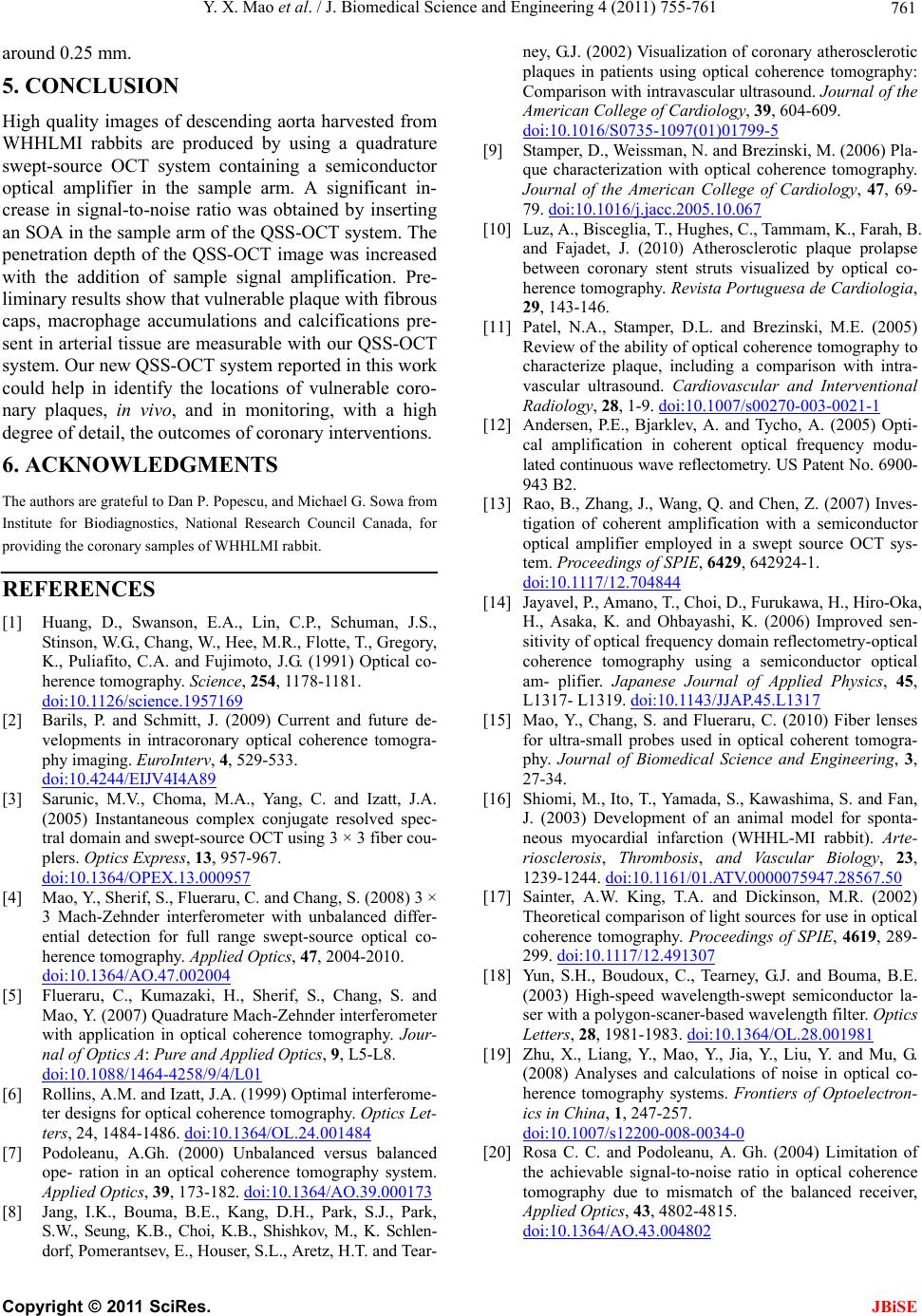
Y. X. Mao et al. / J. Biomedical Science and Engineering 4 (2011) 755-761 761
around 0.25 mm.
5. CONCLUSION
High quality images of descending aorta harvested from
WHHLMI rabbits are produced by using a quadrature
swept-source OCT system containing a semiconductor
optical amplifier in the sample arm. A significant in-
crease in signal-to-noise ratio was obtained by inserting
an SOA in the sample arm of the QSS-OCT system. The
penetration depth of the QSS-OCT image was increased
with the addition of sample signal amplification. Pre-
liminary results show that vulnerable plaque with fibrous
caps, macrophage accumulations and calcifications pre-
sent in arterial tissue are measurable with our QSS-OCT
system. Our new QSS-OCT system reported in this work
could help in identify the locations of vulnerable coro-
nary plaques, in vivo, and in monitoring, with a high
degree of detail, the outcomes of coronary interventions.
6. ACKNOWLEDGMENTS
The authors are grateful to Dan P. Popescu, and Michael G. Sowa from
Institute for Biodiagnostics, National Research Council Canada, for
providing the coronary samples of WHHLMI rabbit.
REFERENCES
[1] Huang, D., Swanson, E.A., Lin, C.P., Schuman, J.S.,
Stinson, W.G., Chang, W., Hee, M.R., Flotte, T., Gregory,
K., Puliafito, C.A. and Fujimoto, J.G. (1991) Optical co-
herence tomography. Science, 254, 1178-1181.
doi:10.1126/science.1957169
[2] Barils, P. and Schmitt, J. (2009) Current and future de-
velopments in intracoronary optical coherence tomogra-
phy imaging. EuroInterv, 4, 529-533.
doi:10.4244/EIJV4I4A89
[3] Sarunic, M.V., Choma, M.A., Yang, C. and Izatt, J.A.
(2005) Instantaneous complex conjugate resolved spec-
tral domain and swept-source OCT using 3 × 3 fiber cou-
plers. Optics Express, 13, 957-967.
doi:10.1364/OPEX.13.000957
[4] Mao, Y., Sherif, S., Flueraru, C. and Chang, S. (2008) 3 ×
3 Mach-Zehnder interferometer with unbalanced differ-
ential detection for full range swept-source optical co-
herence tomography. Applied Optics, 47, 2004-2010.
doi:10.1364/AO.47.002004
[5] Flueraru, C., Kumazaki, H., Sherif, S., Chang, S. and
Mao, Y. (2007) Quadrature Mach-Zehnder interferometer
with application in optical coherence tomography. Jour-
nal of Optics A: Pure and Applied Optics, 9, L5-L8.
doi:10.1088/1464-4258/9/4/L01
[6] Rollins, A.M. and Izatt, J.A. (1999) Optimal interferome-
ter designs for optical coherence tomography. Optics Let-
ters, 24, 1484-1486. doi:10.1364/OL.24.001484
[7] Podoleanu, A.Gh. (2000) Unbalanced versus balanced
ope- ration in an optical coherence tomography system.
Applied Optics, 39, 173-182. doi:10.1364/AO.39.000173
[8] Jang, I.K., Bouma, B.E., Kang, D.H., Park, S.J., Park,
S.W., Seung, K.B., Choi, K.B., Shishkov, M., K. Schlen-
dorf, Pomerantsev, E., Houser, S.L., Aretz, H.T. and Tear-
ney, G.J. (2002) Visualization of coronary atherosclerotic
plaques in patients using optical coherence tomography:
Comparison with intravascular ultrasound. Journal of the
American College of Cardiology, 39, 604-609.
doi:10.1016/S0735-1097(01)01799-5
[9] Stamper, D., Weissman, N. and Brezinski, M. (2006) Pla-
que characterization with optical coherence tomography.
Journal of the American College of Cardiology, 47, 69-
79. doi:10.1016/j.jacc.2005.10.067
[10] Luz, A., Bisceglia, T., Hughes, C., Tammam, K., Farah, B.
and Fajadet, J. (2010) Atherosclerotic plaque prolapse
between coronary stent struts visualized by optical co-
herence tomography. Revista Portuguesa de Cardiologia,
29, 143-146.
[11] Patel, N.A., Stamper, D.L. and Brezinski, M.E. (2005)
Review of the ability of optical coherence tomography to
characterize plaque, including a comparison with intra-
vascular ultrasound. Cardiovascular and Interventional
Radiology, 28, 1-9. doi:10.1007/s00270-003-0021-1
[12] Andersen, P.E., Bjarklev, A. and Tycho, A. (2005) Opti-
cal amplification in coherent optical frequency modu-
lated continuous wave reflectometry. US Patent No. 6900-
943 B2.
[13] Rao, B., Zhang, J., Wang, Q. and Chen, Z. (2007) Inves-
tigation of coherent amplification with a semiconductor
optical amplifier employed in a swept source OCT sys-
tem. Proceedings of SPIE, 6429, 642924-1.
doi:10.1117/12.704844
[14] Jayavel, P., Amano, T., Choi, D., Furukawa, H., Hiro-Oka,
H., Asaka, K. and Ohbayashi, K. (2006) Improved sen-
sitivity of optical frequency domain reflectometry-optical
coherence tomography using a semiconductor optical
am- plifier. Japanese Journal of Applied Physics, 45,
L1317- L1319. doi:10.1143/JJAP.45.L1317
[15] Mao, Y., Chang, S. and Flueraru, C. (2010) Fiber lenses
for ultra-small probes used in optical coherent tomogra-
phy. Journal of Biomedical Science and Engineering, 3,
27-34.
[16] Shiomi, M., Ito, T., Yamada, S., Kawashima, S. and Fan,
J. (2003) Development of an animal model for sponta-
neous myocardial infarction (WHHL-MI rabbit). Arte-
riosclerosis, Thrombosis, and Vascular Biology, 23,
1239-1244. doi:10.1161/01.ATV.0000075947.28567.50
[17] Sainter, A.W. King, T.A. and Dickinson, M.R. (2002)
Theoretical comparison of light sources for use in optical
coherence tomography. Proceedings of SPIE, 4619, 289-
299. doi:10.1117/12.491307
[18] Yun, S.H., Boudoux, C., Tearney, G.J. and Bouma, B.E.
(2003) High-speed wavelength-swept semiconductor la-
ser with a polygon-scaner-based wavelength filter. Optics
Letters, 28, 1981-1983. doi:10.1364/OL.28.001981
[19] Zhu, X., Liang, Y., Mao, Y., Jia, Y., Liu, Y. and Mu, G.
(2008) Analyses and calculations of noise in optical co-
herence tomography systems. Frontiers of Optoelectron-
ics in China, 1, 247-257.
doi:10.1007/s12200-008-0034-0
[20] Rosa C. C. and Podoleanu, A. Gh. (2004) Limitation of
the achievable signal-to-noise ratio in optical coherence
tomography due to mismatch of the balanced receiver,
Applied Optics, 43, 4802-4815.
doi:10.1364/AO.43.004802
C
opyright © 2011 SciRes. JBiSE